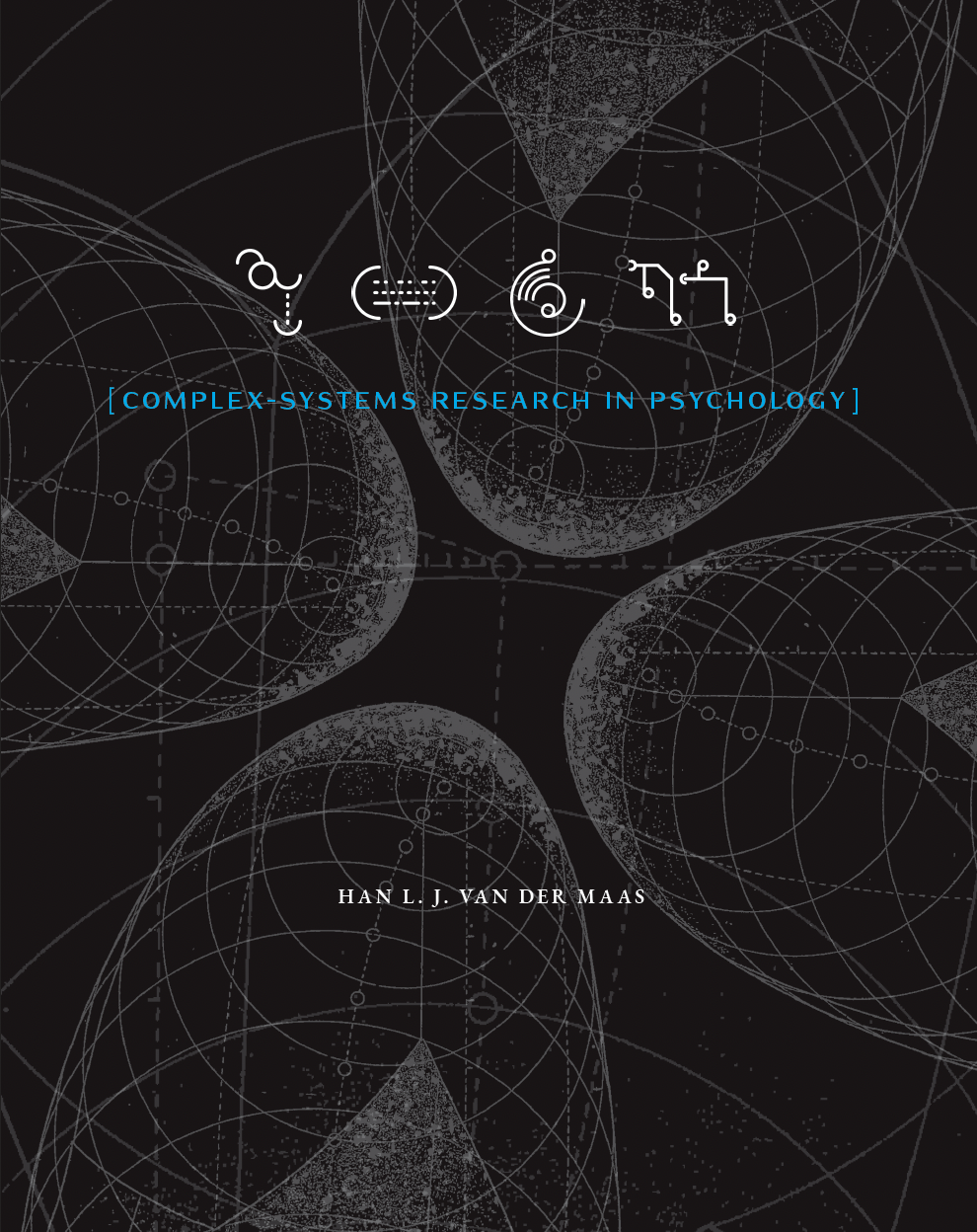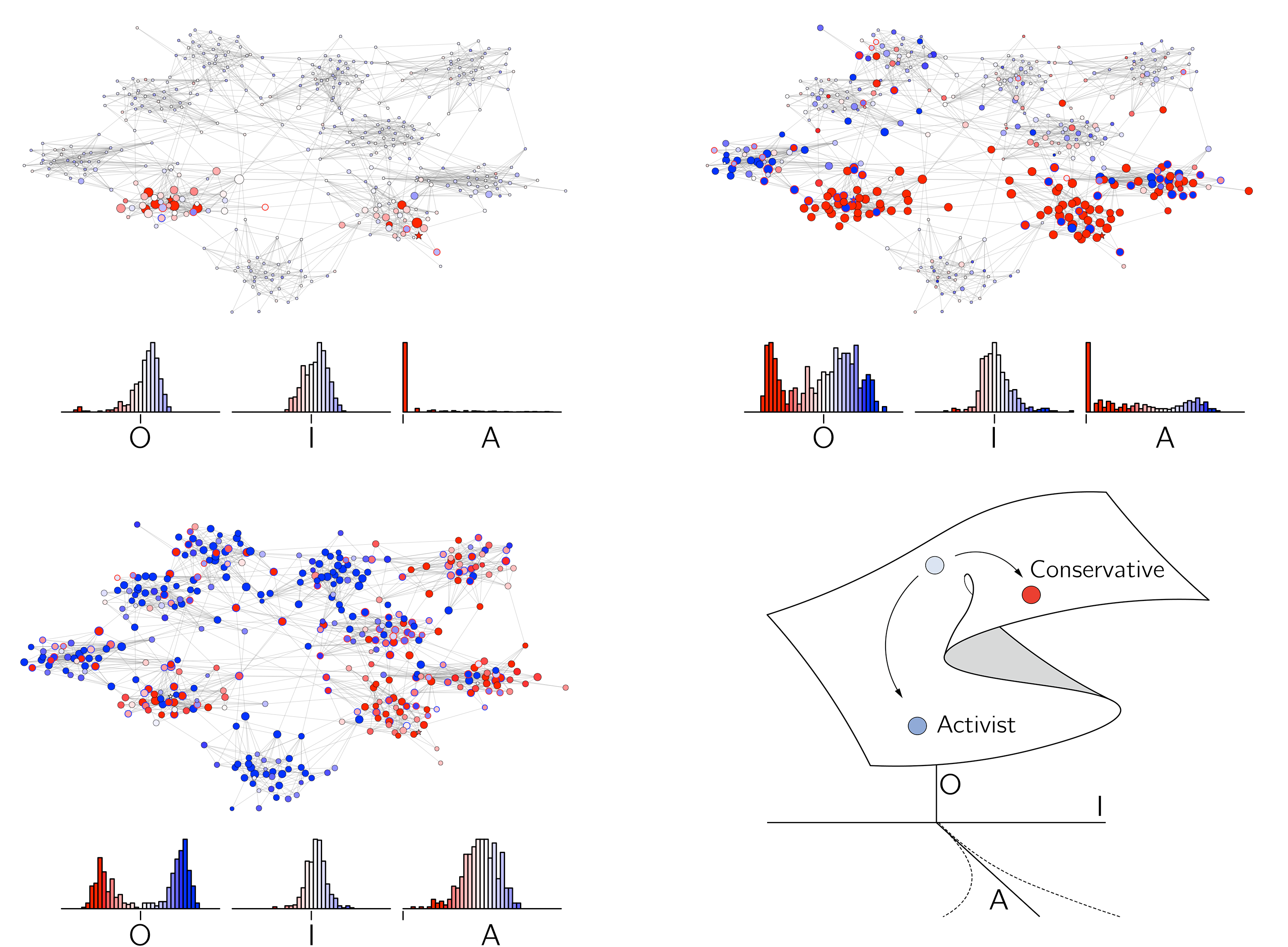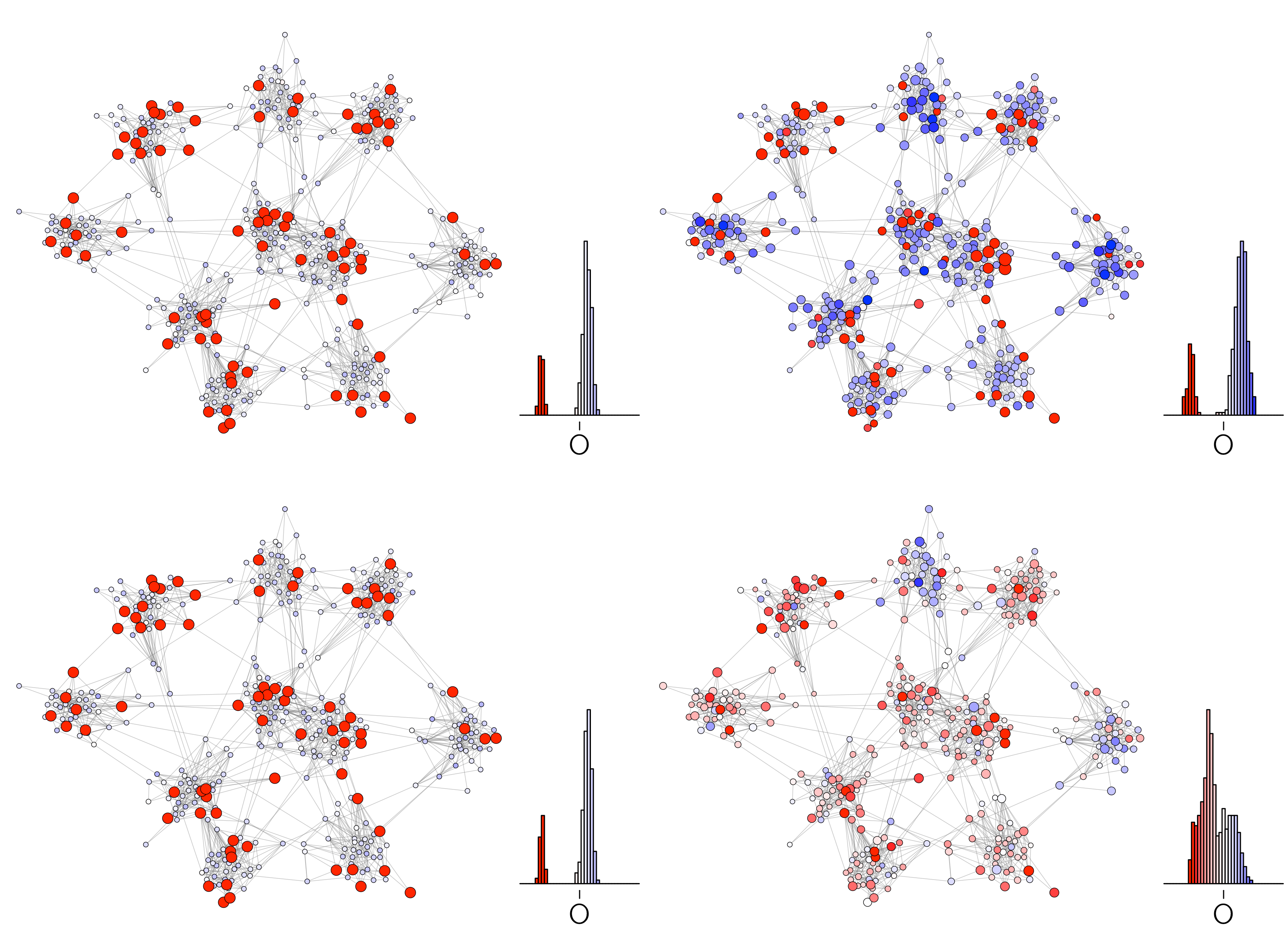resample <- function(x, ...) x[sample.int(length(x), ...)]
n <- 1000; iter <- 100000
x <- vector("list", n)
n_possible_words <- 1000000 # should be very high
total_words <- total_unique_words <- numeric(iter)
for(i in 1:iter){
j <- sample(1:n, 1) # speaker
k <- sample((1:n)[-i], 1) # hearer
# if speaker has no words, make one up (actually just number)
if(length(x[[j]]) == 0) x[[j]][1] <- sample(1:n_possible_words, 1) else
{
spoken_word <- resample(x[[j]], 1) # choose a word (actually just number)
if(any(x[[k]]%in%spoken_word)) # hearer knows the word
{
x[[j]] <- spoken_word # erase list except spoken_word
x[[k]] <- spoken_word # erase list except spoken_word
} else # hearer does not know the word
x[[k]] <- c(x[[k]], spoken_word) # add word to list
}
total_words[i] <- length(unlist(x))
total_unique_words[i] <- length(unique(unlist(x)))
}
layout(1:2)
plot(total_words, type = 'l', xlab = 'time', bty = 'n')
plot(total_unique_words, type = 'l', xlab = 'time', bty = 'n')
unique(unlist(x)) # winning word7 Sociophysics
7.1 Introduction
This final chapter is dedicated to the dynamics between people. Networks of social interactions undoubtedly meet the criteria of a complex system and often exhibit unpredictability, sudden changes, and self-organization. Models of the dynamics between people are the domain of social scientists, such as sociologists, but also scientists with a background in statistical physics. Again, it is necessary to simplify, and the victim in this case is psychology. It is a challenge to add a little more psychology to the agents in these models so that more phenomena can be explained without making these models too complex to study. It is very easy to cross that line. The second part of the chapter deals with what I call psychosocial models.
I use the somewhat controversial term sociophysics as a label for this very diverse field of research, which has roots in many different sciences. It is as (in)correct as the generally accepted term psychophysics in psychology. What I like about it is that it emphasizes the intention to arrive at a formalized, mathematically stated theory of social processes, often based on formalisms first developed in physics. Alternative labels are social physics, computational social science, and agent-based modeling (Goldstone and Janssen 2005).
In my broad definition of sociophysics, it deals with many different systems and processes. Examples that I have already discussed are the synchronization of movement, such as in the swinging of legs in a two-person system or in a crowd of people fleeing a fire in a building. Granovetter’s threshold model of joining a dancing crowd is another example. Many papers deal with the spread of opinions, fashions, rumors, etc. This will be the main topic of this chapter. But this field also includes work on segregation, cooperation, crime, economic systems, and much more. I will present some key examples and then turn to models of the social dynamics of opinions.
Some important follow-up books to read are Smaldino (2023) on modeling social behavior; Bowles and Gintis (2011) on cooperation and altruism; Durlauf and Young (2001) on modeling social economics; Epstein and Axtell (1996), Epstein (2006), and Epstein (2014) on building artificial societies; and Miller and Page (2007) on computation models of social life. There are also some excellent review articles on this area of research (Castellano, Fortunato, and Loreto 2009; Noorazar 2020; Proskurnikov and Tempo 2017; Jusup et al. 2022). A less mathematically focused review is provided by Flache et al. (2017).
7.2 Some famous examples
7.2.1 Segregation
The most famous computational model for studying segregation is Schelling’s model (Schelling 1971). The simplified version of this model assumes a two-dimensional space, a cellular automaton as in NetLogo, where each location or cell is occupied by one of two types of agents or is empty. The density parameter determines how many locations are occupied. Agents stay at their location if a certain percentage of their eight neighbors, \(B\), are of the same type as the agent. So, if \(B = 0\%\), nobody moves. For values of B close to 100%, everybody moves all the time. What Schelling showed with his model was that even low levels of intolerance, near 30%, lead to segregation.
The NetLogo model Segregation (Social Science sample model) demonstrates this model. Especially at high densities, transitions between the unsegregated state, the segregated state, and a mixed state where agents keep moving can be seen (Gauvin, Vannimenus, and Nadal 2009). Instead of playing around with the sliders, we can also use the BehavioralSpace option. Figure 7.1 shows the settings for this option, the R code, and the results. Note that without visualizations NetLogo is pretty fast.
One concept we saw in Chapter 5, Section 5.4.4, in the context of Haken’s work, was that of the order parameter. The order parameter literally measures the order in the system. We look for an order parameter that captures the qualitative phenomena in the model, such as sudden changes and hysteresis. In the NetLogo simulation, I used the percentage of similar neighbors. Gauvin, Vannimenus, and Nadal (2009) propose two, probably better, order parameters: a segregation coefficient, which requires the identification of clusters, and the density of unwanted locations, which better distinguishes between the three states of the system.
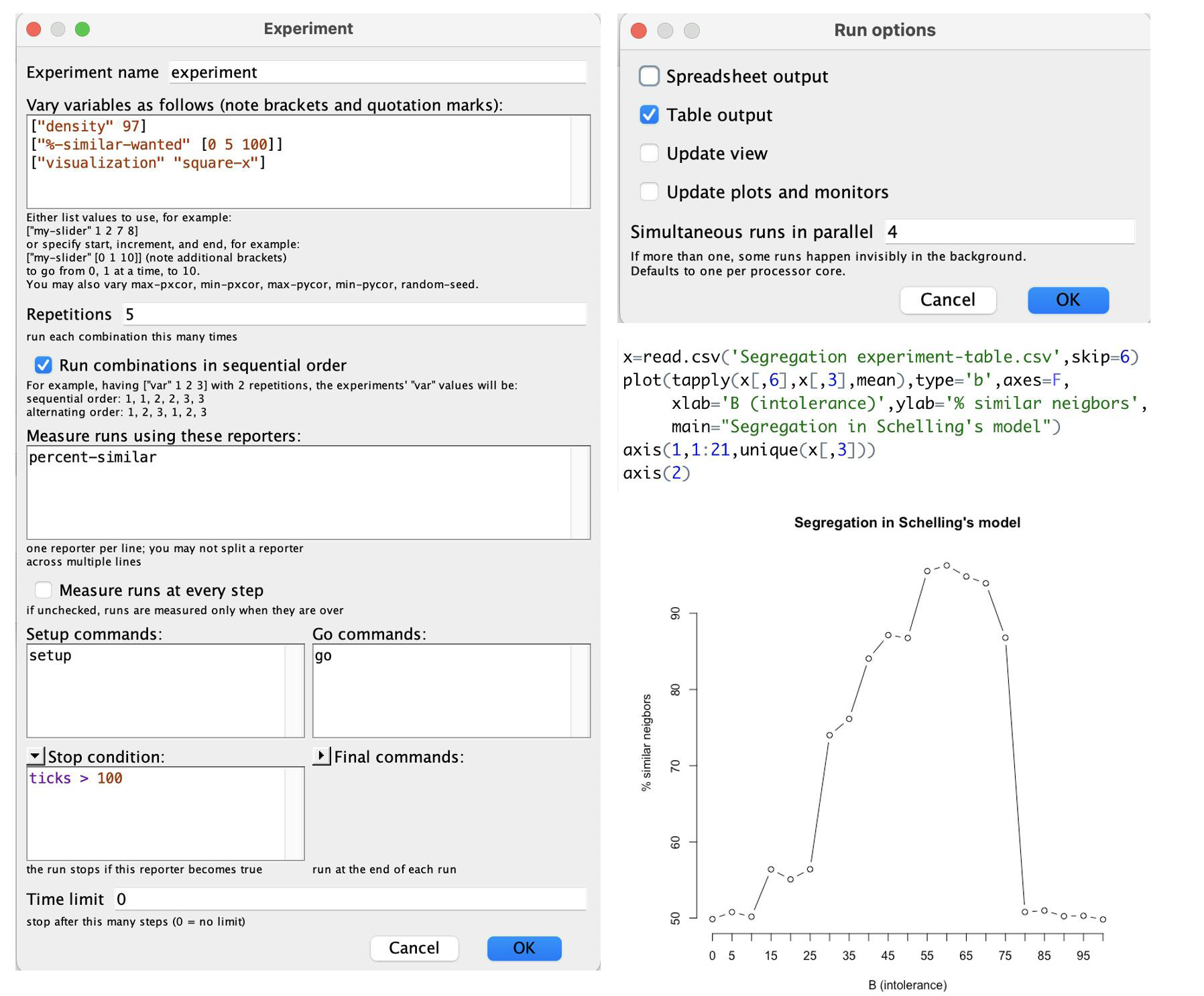
Clearly, this is only an initial model that can be extended in many ways, some of which are already explored in Schelling’s original paper. For an interesting historical sketch of this line of research, see Hegselmann (2017). Another NetLogo model inspired by Schelling’s research is called Party. In this model, partygoers experience discomfort and change their groups if their current group consists of a disproportionate number of individuals of the opposite sex. A recent review with a focus on urban dynamics can be found in Jusup et al. (2022).
7.2.2 The evolution of language: The naming game
Languages are complex systems that emerge in a self-organizing cultural process (Steels 1995). Steels developed the naming game (figure 7.2) to study the evolution of language. For a review I refer to Chen and Lou (2019). Castellano, Fortunato, and Loreto (2009) provide a brief review.
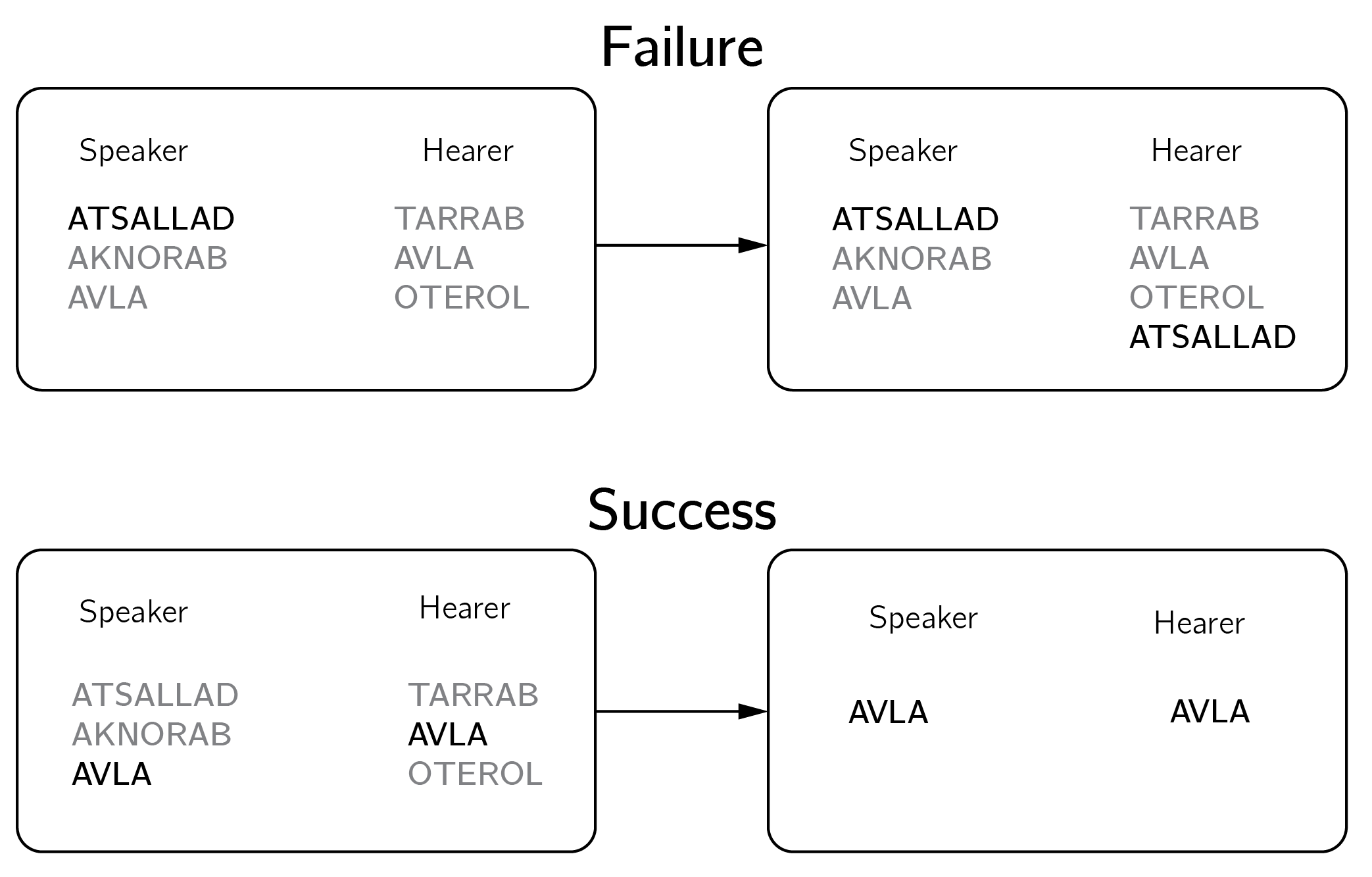
The game begins with blank lists for all agents. In the first round, the speakers invent a new unique word, assuming that the possibilities are endless. We assume that there is only one object to name and that the social network is fully connected. Two agents are randomly selected from a population: one as the “speaker” and the other as the “hearer.” The speaker chooses a word from her vocabulary for the object. If the hearer is unfamiliar with the word, she incorporates it into her lexicon. If she recognizes the word, both clear their vocabularies, retaining only the word that was spoken.
The R code to simulate this process is:
Which results in figure 7.3.
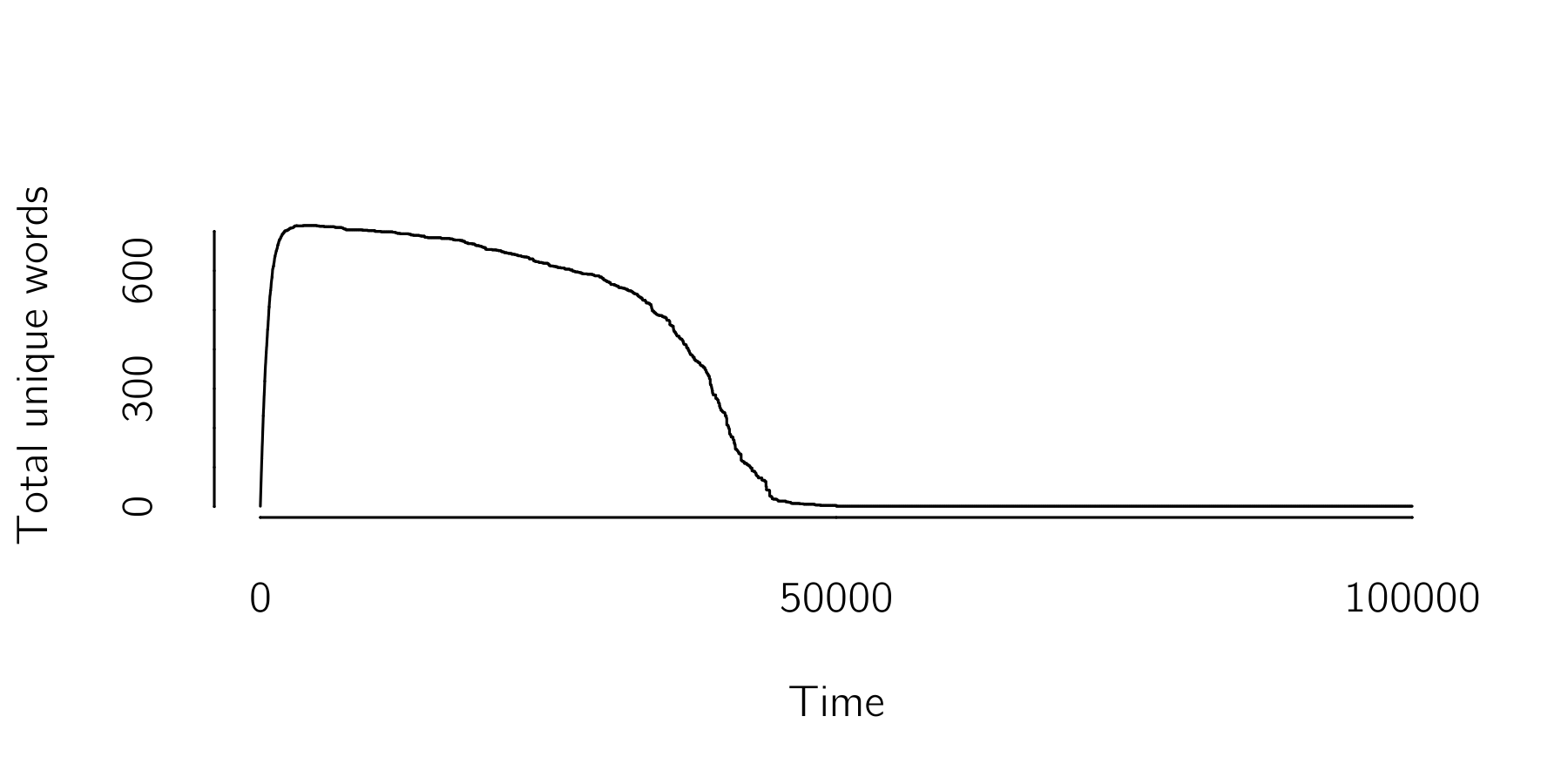
After a phase in which agents use lots of different words, a language consisting of just a single word emerges abruptly. A simplification would be the case that agents start with either word A, word B, or both words A and B. So no new words are invented. For this case we can write the time evolution in three differential equations:
\[ \begin{gathered} {\frac{{dX}_{A}}{dt} = {- X}_{B}X_{A} + {\frac{1}{2}}X_{AB}X_{AB} + X_{A}X_{AB}}, \\ {\frac{{dX}_{B}}{dt} = {- X}_{A}X_{B} + {\frac{1}{2}}X_{AB}X_{AB} + X_{B}X_{AB}}, \\ \frac{{dX}_{AB}}{dt} = {2X}_{A}X_{B} - X_{AB}X_{AB} - (X_{A}+ X_{B})X_{AB}. \end{gathered} \tag{7.1}\]
The first equation can be understood as follows: Speakers B talking to listeners A turn listeners A into AB agents. The loss in A agents is \({- X}_{B}X_{A}\). AB agents talking to AB agents become A or B agents, depending on the speaker’s random choice of A or B (\({X}_{AB}X_{AB}/2\)). If speaker A talks to an AB agent, the latter becomes an A agent (\(X_{A}X_{AB})\). These three terms together define the change in \(X_{A}.\) The other equation follow the same logic. It is easy to implement this in Grind. There are three possible outcomes: (1) If the initial proportion of A is greater than B, A wins; (2) if the initial proportion of B is greater than A, B wins; and (3) if these proportions are exactly equal, all three options A, B, and AB coexist, but this equilibrium is unstable.
7.2.3 Cultural dynamics: The Axelrod model
Robert Axelrod (1997) introduced an influential model of cultural diffusion based on the effects of social interactions and homophily. In Axelrod’s model, individuals become more similar through interactions—but only if they already share some cultural features.
In the model, agents have \(F\) cultural features (e.g., beliefs, habits), each of which has \(Q\) possible nominal values. Agents are organized in some kind of network, for instance, a fully connected one. At each time step, two agents are randomly selected. We count the number of shared features, such as features with the same value. This number, divided by \(F\), gives the probability that one of the mismatching features of one of the two agents is set equal to that of the other. Thus, if they differ on all features, nothing happens. If 50% of their features have the same value, then one of the mismatching features will change for one of the agents with a probability of 0.5.
The combination of interaction and homophily creates a self-reinforcing dynamic that often leads to global convergence toward a single culture. However, for certain choices of \(F\) and \(Q\), the model converges to a state of diversity. In the simulation below, I use the number of remaining cultures as a simple order parameter. Castellano, Marsili, and Vespignani (2000) present detailed analyses of the phase transitions in this model using more advanced order parameters. As you can imagine, this model can be extended in many ways, for instance by introducing ordinal instead of nominal states (Macy, Flache, and Takacs 2006).
The following R code of this model generates the first plot in figure 7.4 . You can play with the values to see different cases.
resample <- function(x, ...) x[sample.int(length(x), ...)]
n <- 100; iter <- 50000
F <- 4 # features
Q <- 4 # nominal levels per feature
uniques <- numeric(iter)
x <- matrix(sample(1:Q, replace = TRUE, n * F), n, F)
for(i in 1:iter){
j <- sample(1:n, 1) # agent 1
k <- sample((1:n)[-j], 1) # agent 2
w <- sum(x[j,] == x[k,])/F # agreement
if(w < 1 & runif(1) < w) {
# which (unequal) feature to update:
f <- resample(which(x[j,] != x[k,]), 1)
x[j,f] <- x[k,f] # update
}
uniques[i] <- nrow(unique(x))
}
plot(uniques[1:i], type = 'l', lwd = 2, xlab = 'time',
ylab = '# unique cultures', bty = 'n', ylim = c(0, 80),
main = paste0('Axelrod model with F = ', F, ', Q = ', Q))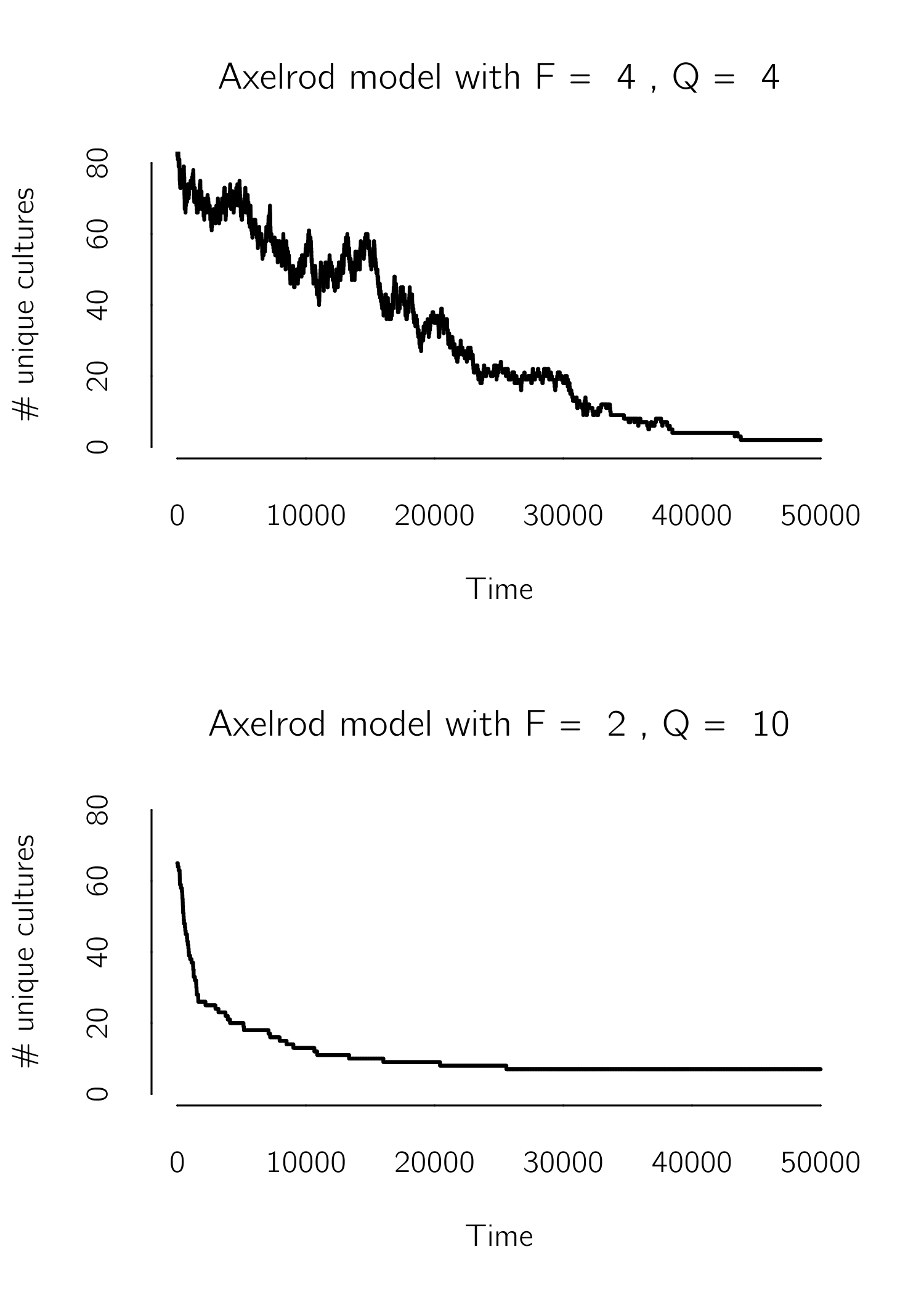
What I find appealing about the Axelrod model is its multidimensionality. Many are more concerned about polarization in the United States than in the Netherlands. In the United States, it seems that all aspects of life are interconnected, and even seemingly unrelated factors such as one’s choice of jeans or favorite sport are correlated with one’s political beliefs. This greatly limits the possibilities for depolarization.
7.3 Dynamics of opinions
In that same famous paper, Axelrod asked an important question: “If people tend to become more alike in their beliefs, attitudes, and behavior when they interact, why don’t all such differences eventually disappear?”
The answer to Axelrod’s question is usually posed in terms of limited interactions between agents. In Axelrod’s model, for example, it was due to selective interaction between agents. In continuous-opinion models, it is due to bounded confidence, that is, agents that are too different refuse to interact. In some models, there is simply no connection between subgroups in a network.
It is hard to count the number of opinion-spread models, but it could easily be in the hundreds, if you count all the variants. They all share a few building blocks. First, there has to be some topology to the social network. Modelers make different choices here. Often, fully connected networks are assumed because they allow an analytical (mean-field) approach; others use random networks, lattices, small-world networks, etc. The problem is that we don’t really know how real social networks work, except that they are incredibly complex (Newman and Park 2003). Second, you need to define some interaction rules. For example, two agents might end up in the middle after a discussion, one agent might copy the other’s state, or one agent might take over the majority vote in its local neighborhood. Finally, you have to define opinion. I will first discuss several discrete opinion models.
7.3.1 Discrete opinion models
7.3.1.1 Voter models
The simplest possible model seems to be the voter model. In its basic form, with only two possible opinions (\(-1, 1\)), two connected agents A and B meet, and A simply copies B’s opinion. What happens in this simple system depends on the topology of the network, that is, its dimension (either \(d = 1\) (on a line), \(d = 2\) (a lattice) or \(d > 2)\) and its size \(N\). In more than two dimensions and with infinite size, the voter system does not converge, but in other cases it converges to a state in which all opinions agree (either all \(-1\) or \(1\)) (Castellano, Fortunato, and Loreto 2009; Redner 2019). How long it takes to converge can also be derived analytically. The convergence time is proportional to \(N^{2}\), for voters on a line (\(d = 1\)), \(NlnN\) for \(d = 2\), and \(N\) for \(d > 2\). Thus, the convergence is slowest when agents are connected in a line.
In the heterogeneous voter model, each agent A copies the opinion of agent B with some probability \(r_{i}\). In this way, one can study the effect of stubborn voters (with low \(r_{i}\)). It turns out that the small group of stubborn individuals (sometimes called zealots) can overcome the majority opinion. Many other variants have been analyzed, such as adding memory and noise to the voters (Castellano, Fortunato, and Loreto 2009). It is also possible to consider three groups, left, center, and right, where left and right do not interact. In this case, depending on the initial proportion, we end up in a state of full consensus in one of the states or with a mixture of extremists without centrists (Redner 2019). Finally, the topology of the social network plays a role.
Another approach has been proposed by Martins (2008). The Continuous Opinions and Discrete Actions (CODA) model combines discrete and continuous aspects of opinion dynamics. Agents act discretely but update their continuous opinions based on observations of other agents’ discrete actions.
In CODA, there are two choice options, A and B, and agent \(i\) has some subjective probability \(p_{i}\) that A is the best option, and \({1 - p}_{i}\) for B. The actual choice is made according to \(sgn\left( p_{i} - .5 \right)\), so A is chosen when \(p_{i} > .5\). Next, the agent observes other agents. Agents assume that other agents make rational choices, that is, choose A when A is the best option with a probability \(a\) that is larger than .5. In running the model, it is convenient to work with the log-odds of probabilities, \(v_{i} = ln({p_{i}}/({1 - p_{i}}))\). Using Bayes’s theorem, we can update \(v_{i}\) to \(v_{i} + a\) when agent j chooses A and to \(v_{i} - a\) if the choice is B. Martins (2008) integrates these decision rules with the voter model, showing extreme forms of polarization, that is, a strongly bimodal distribution of opinions.
7.3.1.2 More discrete opinion models: Majority type models
In the voter and Axelrod models, interactions are limited to two agents. When multiple neighbors have an impact on each agent, many new options arise. One option is the Ising model (Galam, Gefen, and Shapir 1982). Agents switch sides with a probability that depends on the states of their neighbors. The temperature variable in the Ising model is translated into randomness in the model. The external field is now interpreted as an external social field. In this way, one can explain phase transitions and hysteresis in opinion dynamics.
Another deeply analyzed option is the majority model (Galam 2008; Redner 2019). Here, a random group of voters is selected, and all voters in this group adopt the local majority opinion. This process can be repeated until convergence to one opinion is reached (which will always happen in a finite population). Galam (2008) sets up this process in a hierarchical fashion (see figure 7.5). Alternatively, only one voter could be influenced by the majority vote in its neighborhood. This corresponds to the Ising model with 0 temperature.
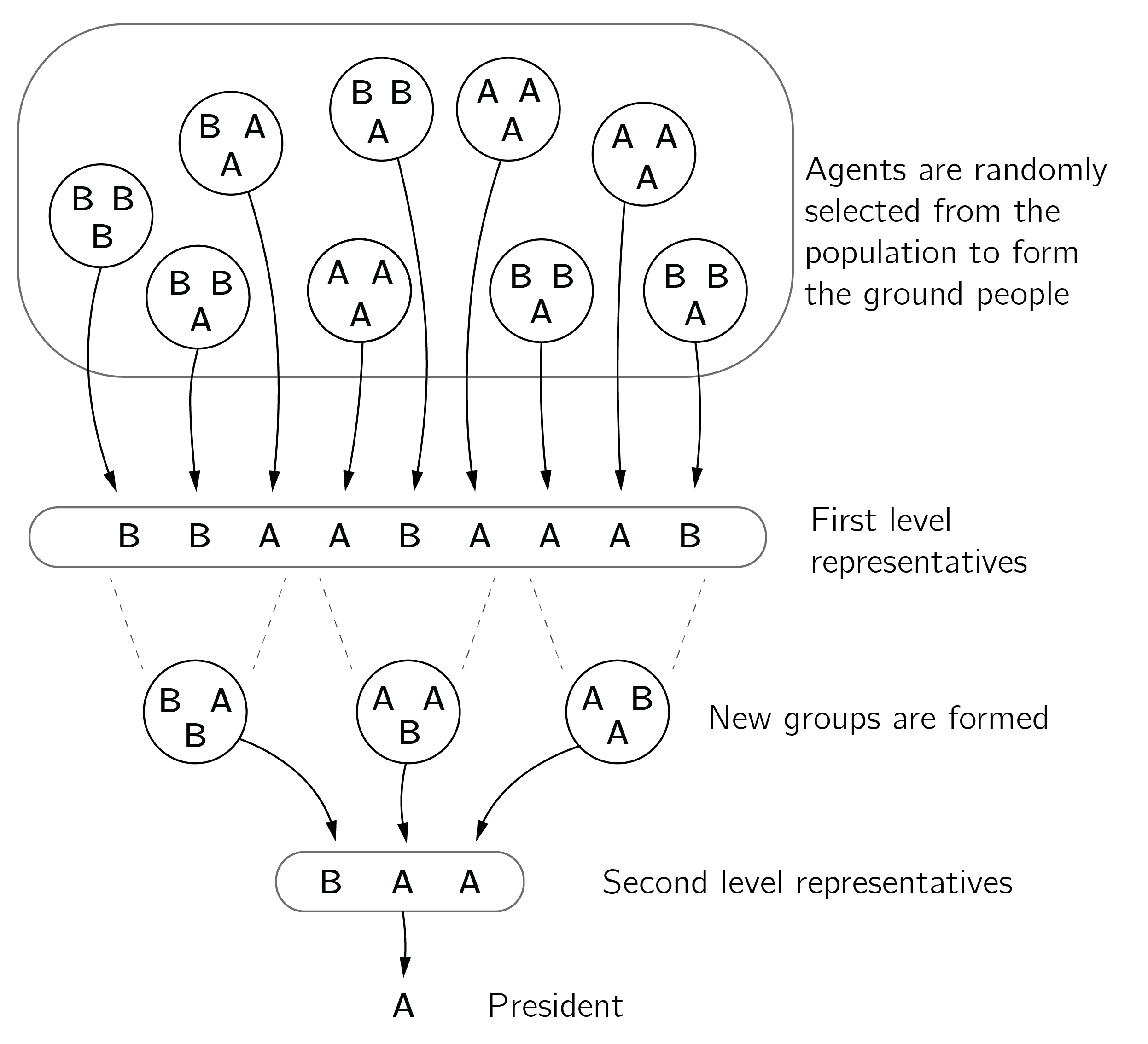
Another case is the \(q\)-voter model (Castellano, Muñoz, and Pastor-Satorras 2009; Jędrzejewski and Sznajd-Weron 2019). Here, agents change their opinions only if all \(q\) voters selected from the neighborhood agree on the other opinion. When \(q = 1\), this reduces to the standard voter model. The \(q\)-voter model generally allows for a higher degree of opinion diversity compared to the basic voter model. The \(q\)-voter model has been implemented in NetLogo (“qvoter_WS” in the user community models).
In the basic Snzadj model, agents are placed on a line, and two neighbors with the same opinion spread this opinion to their own neighbors. If they disagree, they enforce their disagreement on their neighbor. Thus (\(?,1,1,?\)) becomes (\(1,1,1,1\)) and (\(?,-1,1,?\)) becomes (\(1,-1,1,-1\)). This can converge to a state of all \(1\)’s, all \(-1\)’s, or a sequence of \(1\) and \(-1\) pairs. The latter state is reached with a probability of \(.5\). This model has also been extended in many ways, such as adding an election process (Sznajd-Weron, Sznajd, and Weron 2021).
7.3.1.3 Social Impact theory
The last discrete model I mention here is the social impact model, which is based on Bibb Latané’s (1981) psychological theory of social impact. Latané introduced many ideas and concepts from complex-systems theory into social psychology. His psychological theory is firmly grounded in social psychology and supported by all kinds of evidence (Karau and Williams 1993).
In this theory, opinion change depends on social impact \(I\). Opinion \(X\) is either \(-1\) or \(1\). Social impact is a function of the persuasiveness (\(p_{i}\)) of opponents (connected agents with the opposite opinion), the supportiveness (\(s_{i}\)) of supporters (with the same opinion), and the distance (\(d_{ij}\)) to these agents. The effect of distance can be modified with \(\alpha\). As the value of \(\alpha\) increases, the influence of agents located farther away diminishes. All of these parameters are positive random values. The impact \(I\) is defined as:
\[I_{i} = I_{i}^{P} - I_{i}^{S} = \left\lbrack \sum_{j = 1}^{N}{\frac{p_{j}}{d_{ij}^{\alpha}}\left( 1 - X_{i}X_{j} \right)} \right\rbrack - \left\lbrack \sum_{j = 1}^{N}{\frac{s_{j}}{d_{ij}^{\alpha}}\left( 1 + X_{i}X_{j} \right)} \right\rbrack. \tag{7.2}\]
With \(j\) we take the sum over the neighbors of agent \(i\). Note that when \(X_{i} = X_{j}\), \(I^{P} = 0\) due to the \(1 - X_{i}X_{j}\) term, and the same is true for \(I^{S}\) when \(X_{i} \neq X_{j}\). The effects of persuasiveness and supportiveness are reduced as the distance between agents increases. Setting \(\alpha\) to values greater than 1 reduces the effect of distant neighbors. In addition to these forces, the theory assumes an external field \(H\), as in the Ising model. The dynamic of opinion is:
\[X_{i}(t + 1) = - sgn\lbrack X(t)I_{i}(t) + H\rbrack. \tag{7.3}\]
Thus, opinion of agents become \(-1\) if \(X(t)I_{i}(t) + H\) is positive, and vice versa. Lewenstein, Nowak, and Latané (1992) present analytical mean-field solutions for fully connected networks. Without individual fields, the model ends up with an infinite number of stationary opinion states, one of which is usually dominant.
In the presence of individual fields, some minority opinions can become metastable. These smaller minority clusters can also persist for a long time before shrinking again, and the process repeats itself, resulting in what is called staircase behavior (figure 7.6). Such a model can explain why small minority groups (such as flat-earth beliefs) often persist for a long time, against all odds (Douglas, Sutton, and Cichocka 2017).
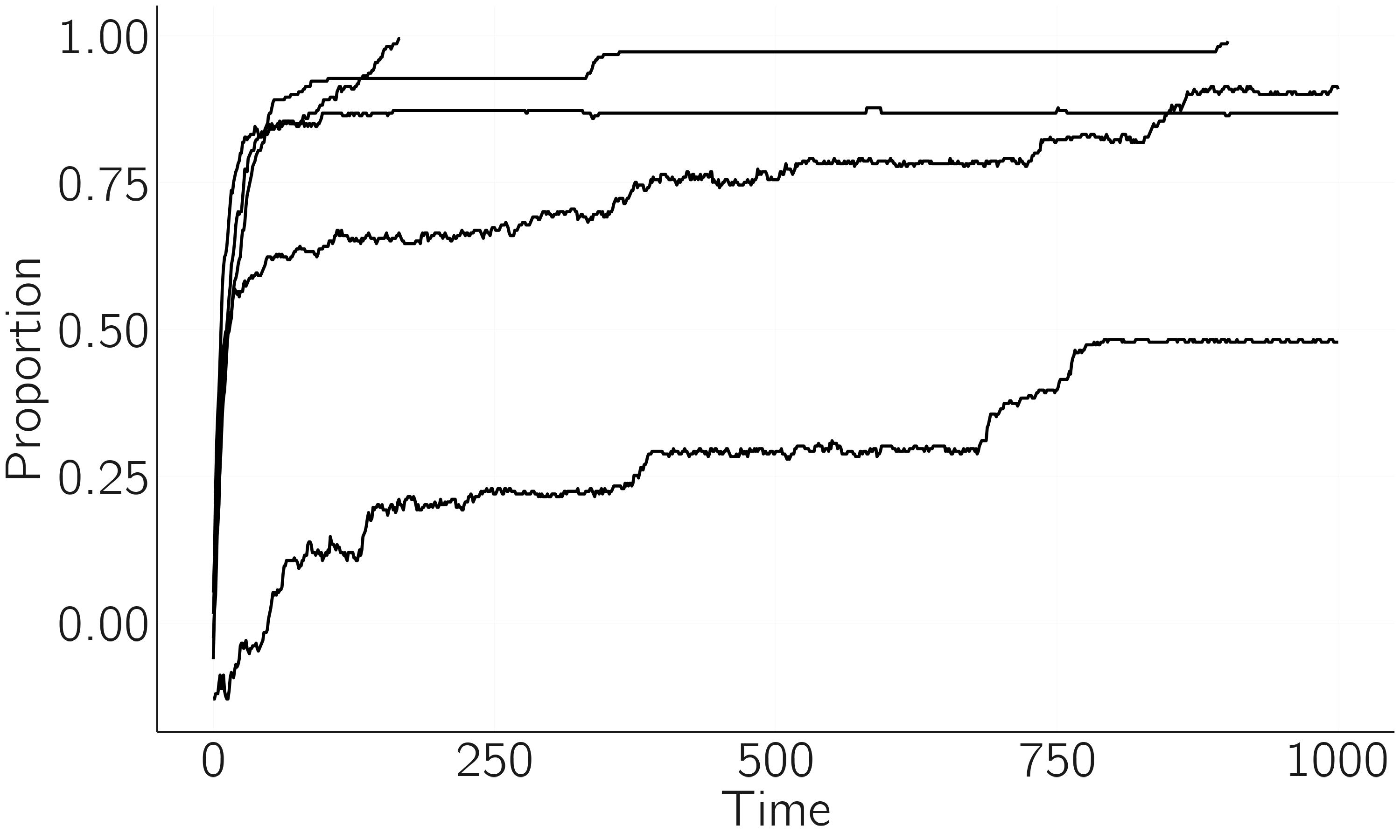
Extensions of this model include learning, leadership, external influences, and identity effects (for a review, see Holyst, Kacperski, and Schweitzer 2001).
7.3.2 Continuous opinion models
7.3.2.1 Classic models
Another line of research, with its own history, starts from the assumption that opinions are continuous variables (for a review, see Noorazar 2020). They will have values between 0 and 1, for instance. A classical model is the DeGroot model, where agents are connected in a weighted network. At each iteration, an agent’s opinion is set equal to the weighted average of all connected agents in the network. In this way, opinions tend to converge (figure 7.7). The Friedkin—Johnson model (Friedkin and Johnsen 1990) is an extension that includes a confidence level for each agent. This agent’s confidence in their own opinion reduces the effect of others. Clustering or polarization in these linear models can only occur if parts of the network are unconnected. The Friedkin—Johnson model can be efficiently simulated with Grind (using the method='euler' option) by:
FJ <- function(t, state, parms){
with(as.list(c(state, parms)),{
X <- state[1:n]
M <- M / apply(M, 1, sum) # weights sum to 1
dX <- (1 - g) * M %*% X + g * X - X
return(list(dX))
})
}
n <- 100
M <- matrix(runif(n^2, 0, 1), n, n)
g <- .95 # if g = 0 => DeGroot model
x0 <- runif(n, 0, 1)
s <- x0; p <- c()
run(odes = FJ, method = 'euler', tmax = 100)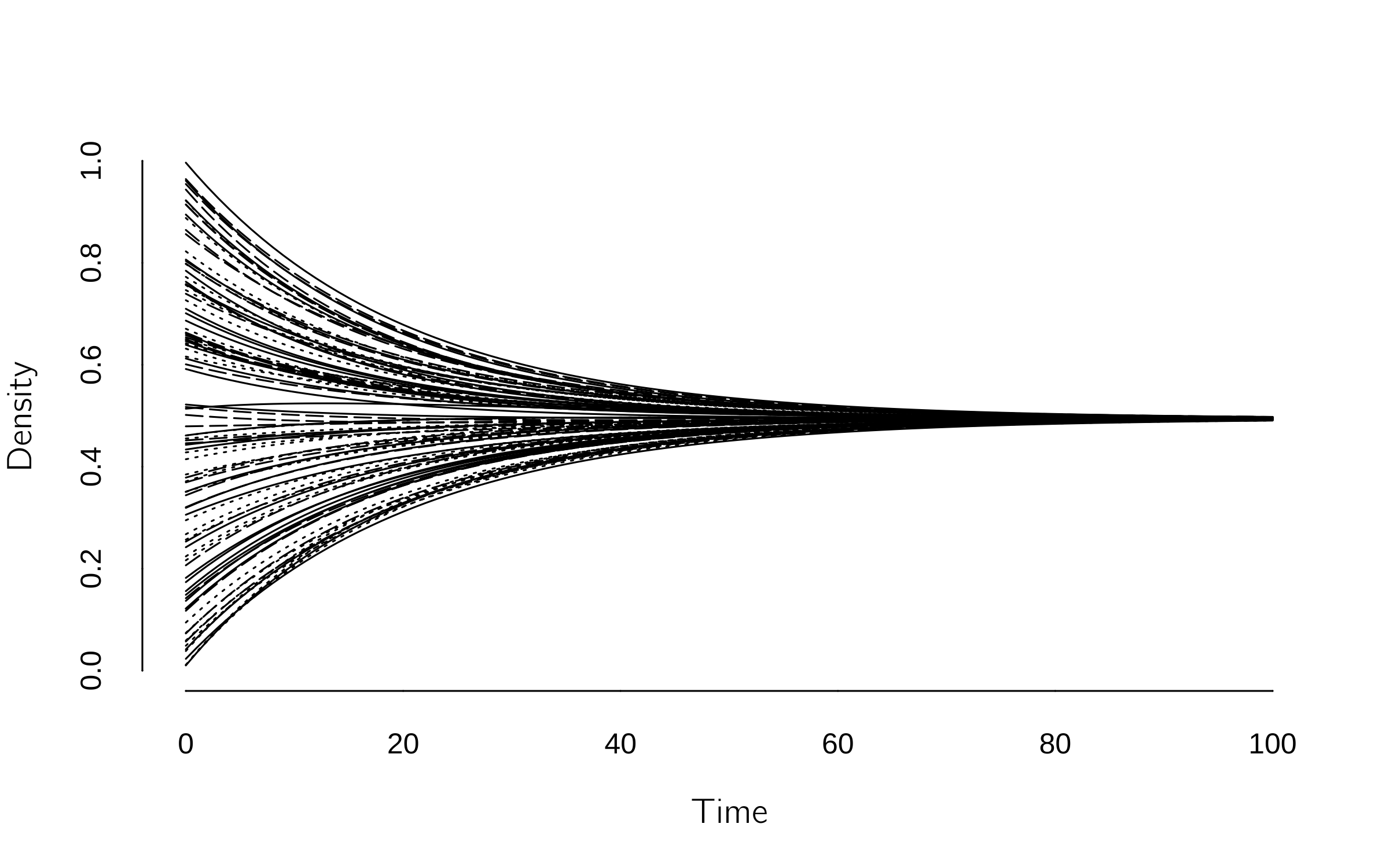
With an additional bias mechanism, in which confirming evidence is weighted more heavily relative to disconfirming evidence, polarization can also occur in connected networks (Dandekar, Goel, and Lee 2013).
7.3.2.2 Bounded confidence
The bounded confidence mechanism has been extensively studied as the most effective way to generate divergence of opinions in continuous opinion models. It assumes that individuals have a limited willingness to accept and consider opinions that differ from their own and will only update their opinions if they are within a certain range or “bound” of similarity.
A simple but very interesting model is the Deffuant model (Deffuant et al. 2000). The initial opinions of n agents are randomly set to values between 0 and 1. At each step, two agents \(i\) and \(j\) meet. If \(\left\lceil X_{i}(t) - X_{j}(t) \right\rceil > \epsilon\) nothing happens because the difference in opinion exceeds the bound \(\epsilon\). Otherwise, they exchange opinions according to:
\[ \begin{gathered} X_{i}(t + 1) = X_{i}(t) + \mu(X_{j}(t) - X_{i}(t)),\\ X_{j}(t + 1) = X_{j}(t) + \mu\left( X_{i}(t) - X_{j}(t) \right). \end{gathered} \tag{7.4}\]
So, if \(\mu = .5\), they find each other in the middle. If \(\mu = 1\), they take each other’s position, as in the voter model. The value of \(\mu\) does not make much difference, but the model converges fastest with \(\mu = .5\). However, the choice of the bound \(\epsilon\) makes a big difference. For \(\epsilon = 0,\) all agents stick to their positions; for \(\epsilon > .5\), they all converge to \(X = .5\). For intermediate values, different forms of clustering occur (figure 7.8). It has been shown that the topology of the network does not make much difference (Fortunato 2004). A drawback of this model is that it converges slowly. A fast but not entirely accurate code to simulate this model is: 1
set.seed(20)
layout(matrix(1:4, 2, 2))
iter <- 50; mu <- .5; n <- 200
for (bound in c(.1, .2, .3, .5)){
x <- runif(n, 0, 1)
dat <- matrix(0, iter, n)
for (i in 1:iter){
y <- sample(x, n, replace = TRUE) # find an partner for every agent
x <- ifelse(abs(x - y) < bound, x + mu * (y - x), x)
dat[i, ] <- x
}
matplot(dat, type = 'l', col = 1, lty = 1, bty = 'n', xlab = '',
ylab = 'opinion', main = paste('bound = ',bound))
}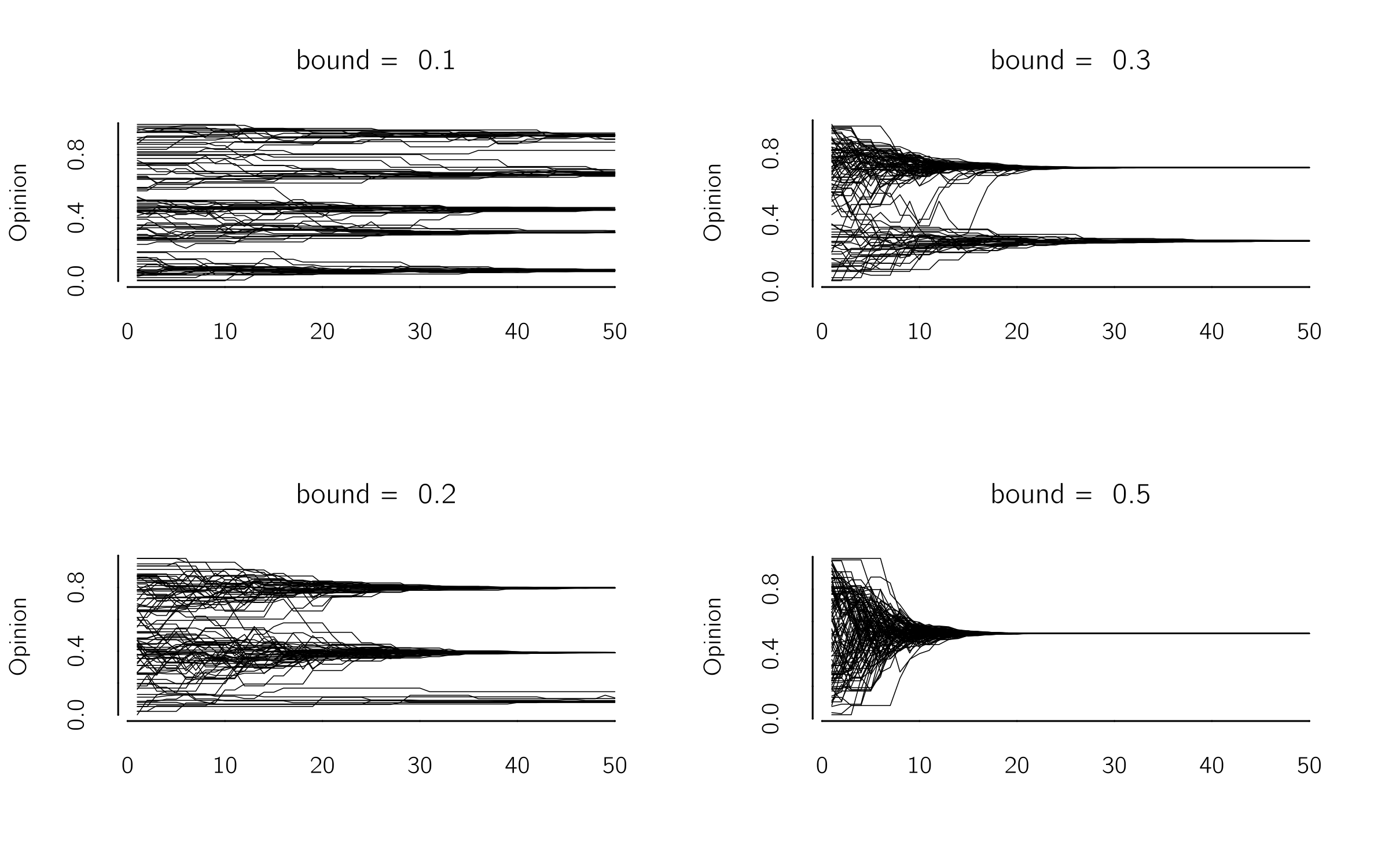
With this code you can explore many scenarios and variants. One interesting option is to have agents with different boundaries (Weisbuch et al. 2002). Also, adding some noise to \(X\) at each time step reduces polarization (Zhang and Zhao 2018). One can also lower the bound with the number of interactions. This increases the polarization (Weisbuch et al. 2002). One case I find interesting is increasing the bound after polarization emerged for a low bound. This gives hysteresis. A bound of .5 is sometimes insufficient to reduce polarization. Castellano, Fortunato, and Loreto (2009) review some other extensions (the role of propaganda, for instance).
Another well-known model is the Hegselmann—Krause model (Rainer and Krause 2002). This model is very similar to the Deffuant model, but instead of communicating with one other agent, they communicate with all connected agents, but only if the difference in opinion with these agents is sufficiently small. Thus, agents average the opinion of all connected agents for which the difference in opinion is less than the bound. This model is an extension of the DeGroot model and can be simulated by adding two lines to the Friedkin—Johnson code,
accepted <- abs(outer(X, X, '-')) < bound # acceptable neighbors
M <- accepted * Mafter the X <- state[1:n] line and adding bound = .1 (figure 7.9).
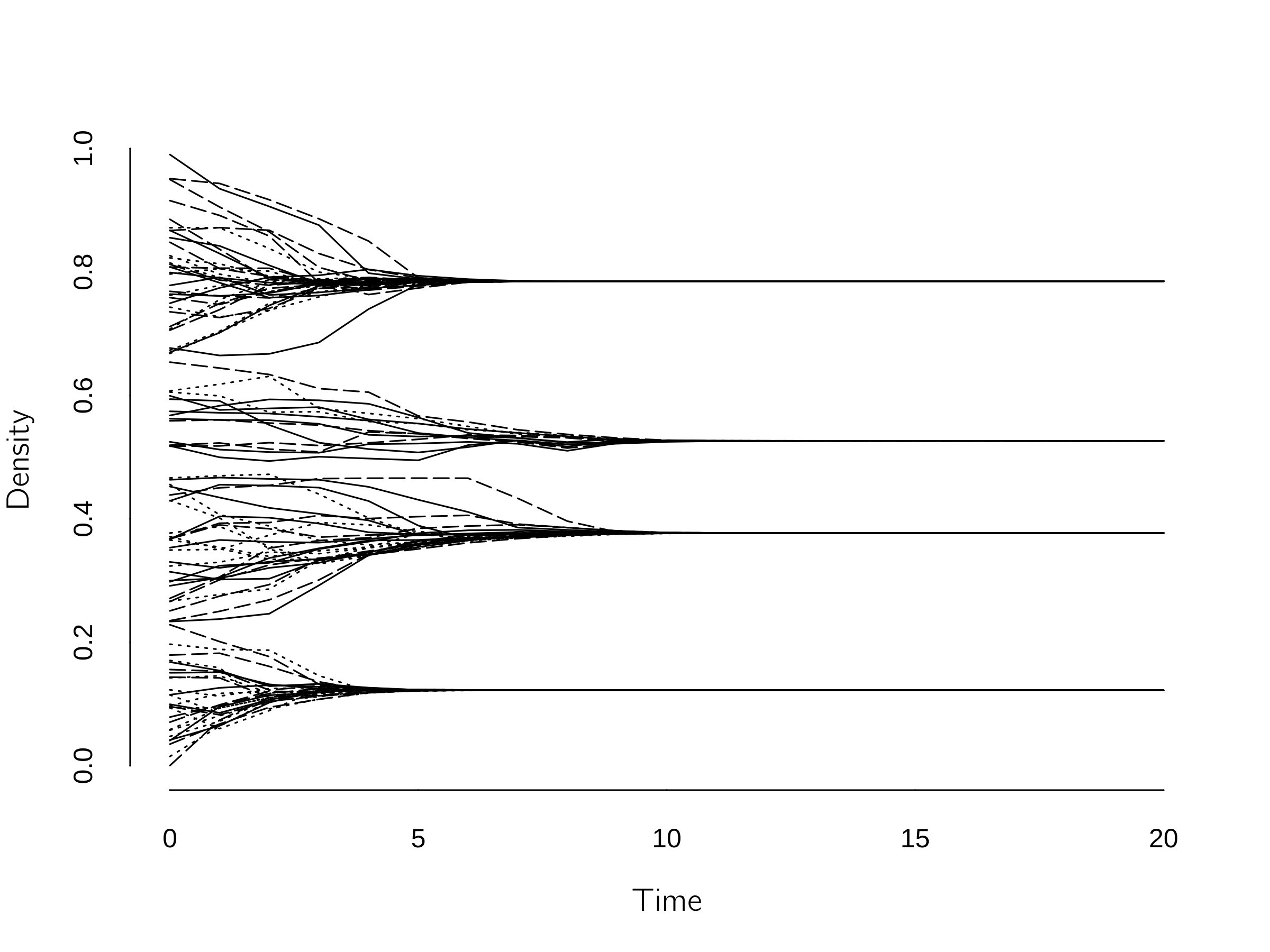
Again, many extensions have been studied. A recent paper studies the case where the network topology is a function of cognitive dissonance in opinions (Li et al. 2020). Baumann et al. (2020) present a continuous opinion model of echo chambers. Of particular interest is the multidimensional case (Lorenz 2007). When agents accept interaction based on the minimum distance along one dimension, consensus can be reached more easily. The idea of bounded confidence has been associated with the concept of the latitude of acceptance as proposed in social judgment theory (Sherif and Hovland 1961). This theory also proposes a latitude of rejection. There are two bounds, a lower and an upper bound. Below the lower bound, agents reduce their differences; between the bounds they ignore each other; and if they differ more than the upper bound, they increase their differences. This scenario has been investigated in Jager and Amblard (2005).
In the online library of NetLogo you can find the model “BC”, which simulates both the standard Deffuant and the Hegselmann—Krause model.
7.3.3 Empirical verification
Castellano, Fortunato, and Loreto (2009) note a striking imbalance between empirical evidence and theoretical models, in favor of the latter. It is not that there are no empirical data on the dynamics of opinions. Data come from studies on voting behavior, multicountry panel surveys, social media, and laboratory studies (for a review, see Peralta, Kertész, and Iñiguez 2022). The problem seems to be that these data do not discriminate between models. Most of the data fit all opinion models, supporting the general modeling approach but not specific models. This relates to the point that current opinion models are difficult to falsify because they lack specificity and are too flexibility. Flache et al. (2017) argue that the field suffers from a lack of systematic comparison of competing models. The theory-construction approach outlined by Borsboom et al. (2021) may be helpful here. We need a list of generally agreed-upon phenomena that all models are supposed to explain.
But another perspective is worth considering. In physics, models can be distinguished by their ability to make precise quantitative predictions. By contrast, in other fields there are often multiple models that roughly explain the same phenomenon, which can be advantageous. For example, Schelling’s segregation model and its various iterations consistently predict that segregation occurs even when individuals are tolerant of different groups, demonstrating a robust prediction. Similarly, different models of traffic congestion tend to predict the same key phenomena. In addition, opinion models consistently show that zealots increase polarization, regardless of the specific model used. This convergence among different models may be the most reliable form of prediction we can achieve in these areas.
7.5 Psychosociophysics
Neglecting the social world while attempting to model complex psychological processes may lead to inaccurate outcomes (Sobkowicz 2020). It is crucial for psychologists engaged in modeling to familiarize themselves with prominent sociophysics modeling techniques. The objective of this chapter was to offer a comprehensive overview of these models, but it is important to note that this review is not exhaustive. As new models continue to emerge, the foundational knowledge provided here will, I hope, enable readers to stay informed and assess their applicability to psychological inquiries.
Similarly, excluding psychological factors while modeling the social world can be counterproductive. It is essential to emphasize the need for psychosocial or even psychosociophysical models that integrate both aspects. The social impact model is as an example of such an approach. Our own model, the HIOM, has been elaborated upon in this chapter. The HIOM stands as a significant step in the direction of psychosociophysics models. The concept of cascading transitions is evidently relevant to other applicable cases, and there is ample opportunity for further exploration in this field.
7.6 Exercises
Rerun the Schelling simulation (figure 7.1) with density of 50 instead of 97. Are the results substantially different? Submit your plot. (*)
Implement the equations (equation 7.1) for the simple naming game in Grind. Show that the case where all three options A, B, and AB coexist is an unstable fixed point. (**)
What happens in the Axelrod model (Section 7.2.3) when \(F = 10\) and \(Q = 1\). Why? (*)
Implement the 1d voter model (Section 7.3.1.1) in either R or NetLogo (using BehaviorSpace and R for data analysis). Check that the probability of convergence to a state is equal to its initial proportion. Then check that the convergence time is a quadratic function of \(N\) by plotting the square root of this time versus \(N\). Take the average of these times for at least 20 runs. (**)
In the social impact model (Section 7.3.1.3), does the staircase behavior depend on the max-h parameter? (*)
In the Deffuant model (Section 7.3.2.2), a limit of .5 almost always leads to convergence of opinions. Adjust the R code for the Deffuant model so that the bound grows from 0 to .5 over 1,000 iterations. You end up with one or two clusters. Why do you end up with two clusters even if you increase the number of iterations? (**)
Run the HIOM NetLogo model (Section 7.4.1.1). Set the
mean-init-informationto .5, themean-init-attentionto 1, theboundto .2, and the%active-agentsto 90. Let it run and useadd-activistsandpertubate activists. Why does this not result in a change? (*)Think of a simple way to add the effect of media to the HIOM. Implement and present your results. (**)
Implement the HIOM in a preferential attachment network. Use the “Preferential Attachment NetLogo” model. (**)
Design an empirical study to test the “meat-eating vegetarian” prediction (Section 7.4.1.5).
The second of the two equations is not implemented. This does not lead to different results as far as I know.↩︎
This is highly relevant to the discussion in psychology about type and continua, that is, whether psychological traits are typological or continuous constructs (Borsboom, et al., 2016). They can be both!↩︎
To incorporate close to linear change in \(O\) as a function of \(I\), I use \(A + A^{\min}\), where \(A^{\min} = -.5\) and \(A ≥ 0\). See the original paper for explanation.↩︎
